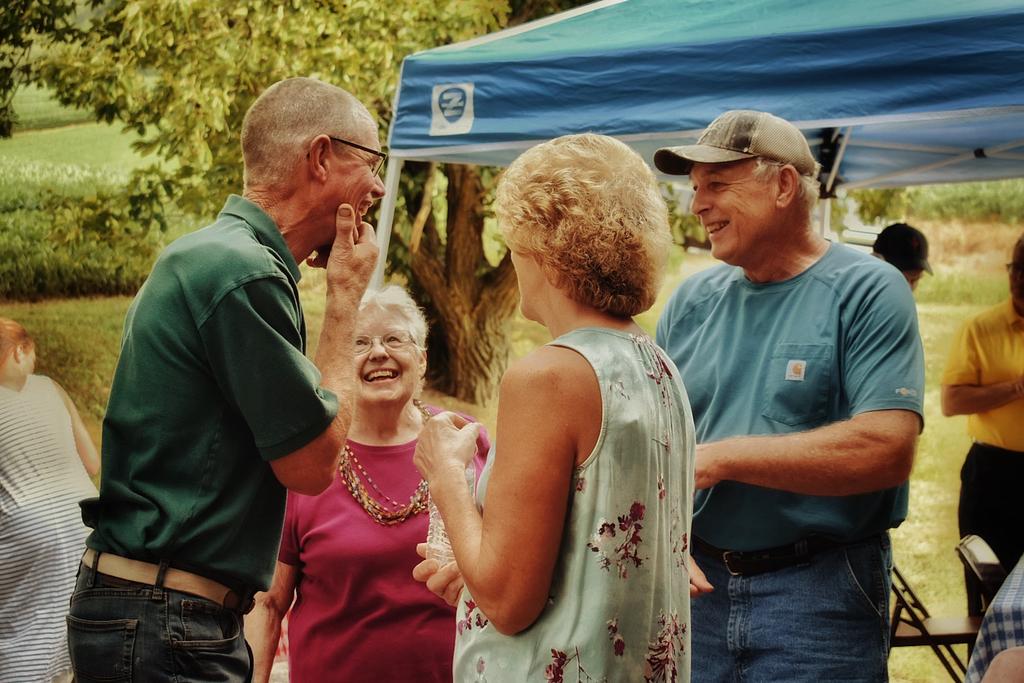
Introduction
Age-friendly communities and Community Based Organizations (CBOs) across the country have developed and grown programs to address increased loneliness and social isolation in aging populations. Programs like telephone reassurance can support older adults safely at home, are highly scalable, and have been shown to have a positive impact on loneliness, anxiety, and depression. At the same time, there are growing demands to understand the outcomes and impact these interventions have on their participants at a localized level. Agencies can make use of data and outcomes tracking technology to better evaluate their own programs and to make the case for increased support from funders and partners. From increasing the reach of programs to providing the groundwork for healthcare partnerships, leveraging technology and data is the key to growing social isolation interventions.
Program Example - How the Council on Aging of Central Oregon Evaluated Its Loneliness Intervention
The Council on Aging of Central Oregon created the Caring Connections program in order to understand and reduce the impact of social isolation and loneliness on seniors in its community. Starting with $75k in pilot funding from the Cares Act, the Council on Aging developed a telephone reassurance program (Caring Connections) and worked to evaluate the program’s impact on participants’ feelings of loneliness and isolation over a period of six months. The Council on Aging partnered with two organizations to launch and evaluate the program: Mon Ami as the technology provider and the Oregon Health and Sciences University (OHSU) Clinical and Translational Research Institute’s Community Research Hub. Growing from a small pilot program and using the data they gathered with the help of their partners, the Caring Connections Program secured another $132k in funding to expand the programs and refine services.
Here's How They Did It -
Consider and plan data collection and evaluation early in the process
Project planning is a vital component of the pathway towards successfully creating a pilot program for your organization. Planning involves aspects such as identifying grants and funding sources, designing and developing call scripts (for friendly caller programs), determining methods of outreach for clients and volunteers, and creating a protocol for collecting, analyzing, and consolidating data. By considering and planning for data collection and evaluation early in the process, you gain the ability to search for grants that specifically support research initiatives - unlocking a new pool of resources to draw from. Additionally, making data collection a foundational piece of your program enables your team to ensure that the impacts of the program are visible. If you have already launched your social isolation program, it’s not too late! Community organizations have seen success implementing technology and data collection protocols at all stages of growth and development.
Design your program
Designing and developing call scripts and reference sheets for staff and volunteers as well as outreach materials for clients and volunteers are two important components of designing your program. It is important to standardize the intake and evaluation process for clients, and it is often helpful to reference other successful programs and model your program after them. Best practices typically include regularly scheduled calls, intergenerational connection, semi-structured and/or informal conversation, etc. For further information on designing and setting up your program, check out this article, ‘How to set up a volunteer telephone reassurance program for seniors.'
Find a research partner (or do it yourself!)
Collecting data will help you gain insight into how effective your programs are at creating concrete impacts within the community. Program data may even alert you and your team to underlying gaps in senior services that were previously unnoticed in your community. For the Caring Connections Program, the Council on Aging of Central Oregon worked with the OSHU Community Research Hub to help design a sound research protocol, choose the right survey tools and methods, and to handle data analysis. A third-party research partner also lends credibility to the study results, which is important when sharing the findings with other organizations and agencies. Look to Figure 1 to see some things to consider when choosing a research partner.
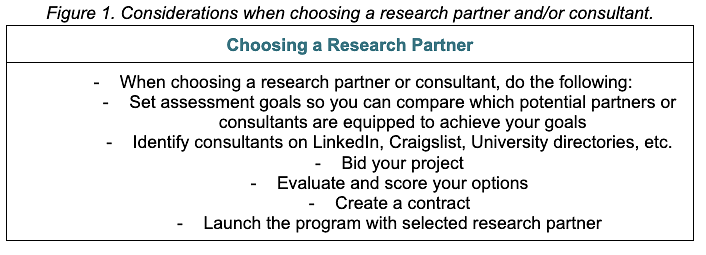
Select an assessment tool
A research study with strong foundations will collect at minimum both pre-intervention (baseline) data as well as post-intervention (reassessment) data for every senior enrolled in the program. These data sets are collected using surveys and questionnaires, also called assessment tools (see Figure 2 for examples of survey questions/tools). When selecting an assessment tool for your program, it is helpful to consider some main characteristics of these tools: 1) Length of survey, 2) Validation, 3) Ease of administration, etc. Some of the most common assessment tools used for social isolation program evaluations are:
- UCLA Loneliness Scale
- Campaign to End Loneliness Measurement Tool
- De Jong Gierveld Loneliness Scale
- Single-item ‘Scales’
Each of these survey and assessment tools has different benefits and drawbacks that should be considered when designing your program. See Figure 3 for a side-by-side comparison of these tools.
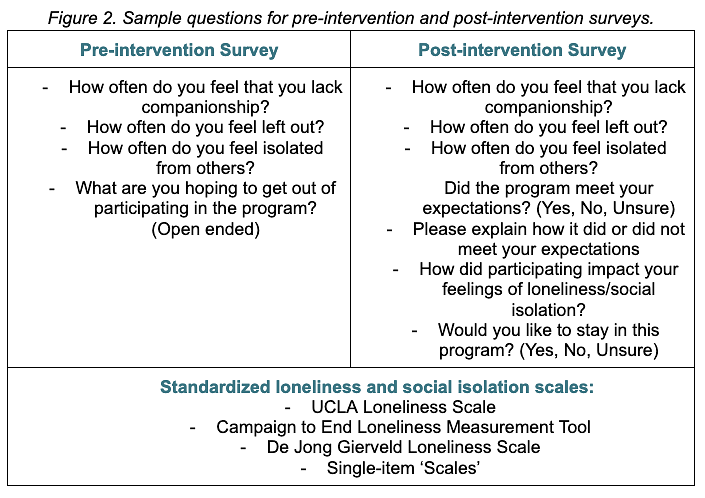
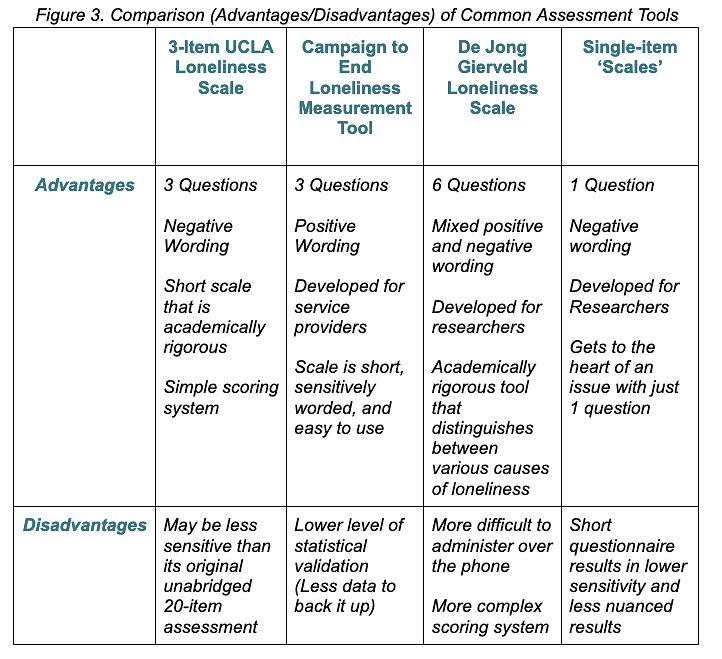
Implement your program and assessment
As you begin to launch your program, keep in mind who will be administering assessments, the timeline for these assessments and the overall logistics of carrying out your program. To begin, your organization should conduct pre-intervention assessments prior to enrolling a client into the program. This will be considered the baseline survey and will provide a foundation for all further assessments. It is important that the assessments are completed by a trained staff member or third party so that each can be administered in a controlled environment and in exactly the same manner (using the same script). It is recommended that volunteers do not conduct the assessment survey for the clients that they serve to avoid bias in the survey responses. Once enrolled, the client and volunteer match will be made, and the client will receive program services for a set period of time as determined during your planning phase. The Caring Companions Program elected to use a 6 month interval between assessments, providing enough time for senior clients to see the benefits of the program’s services. After the given period, your staff member or partner should complete the first follow-up assessment with each client, providing you with the first set of data and results from your research study. This process is then repeated at each assessment point until the end of the study (Refer to Figure 4 for a sample workflow).
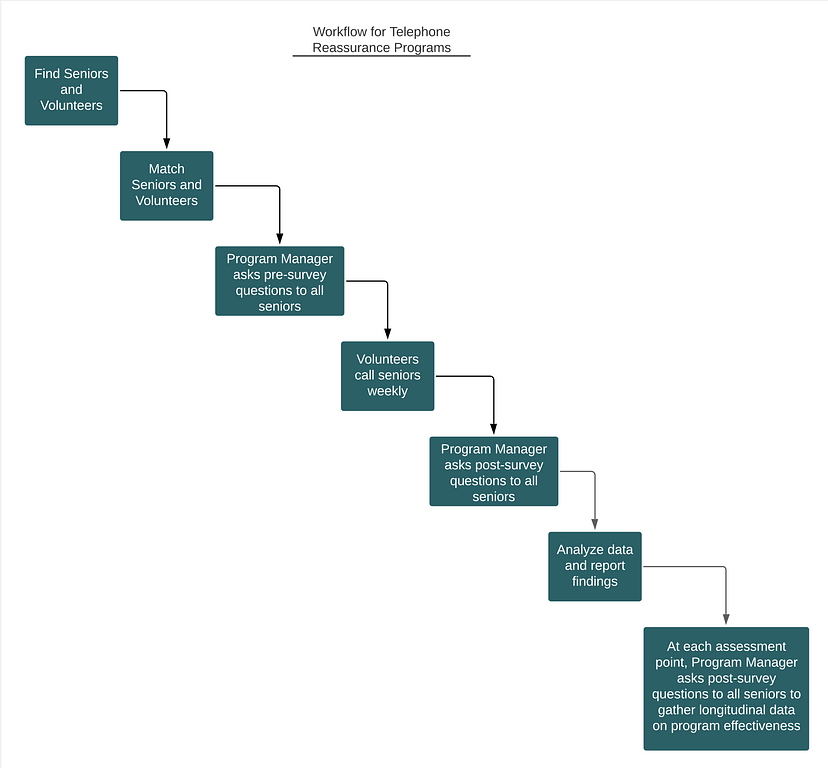
Review and analyze data
After your team has completed the assessments and collected data on the program, you and your research partners must then analyze that data to evaluate the true impact of the program on the community. At this stage, it is important to understand the types of data measured and collected. Refer to Figure 5 to see the various types of data that are most relevant to community impact evaluation. Other data measurements may include number of senior clients participating and enrolled, success of outreach, total number of contacts and the length of calls, senior to volunteer reassignment rate, etc. It is also necessary to think about how these types of data relate to one another - based on the data you have collected, how do your inputs for this program compare to the outputs, outcomes, and impacts of the program? In other words, how does the funding and resources used to launch this program impact outcomes for senior clients in the short- and the long-term.
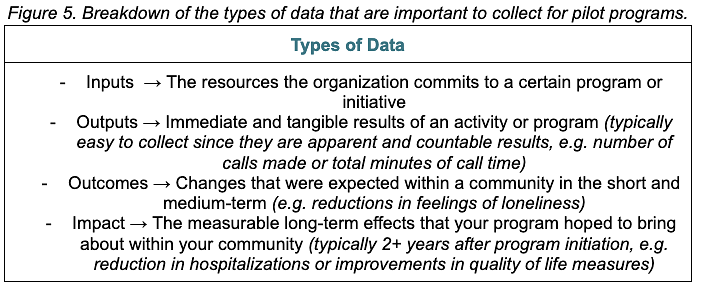
Share your results with others!
Once you have analyzed the data you and your partners have obtained from the pilot study, the final step in the cycle is to share your results so that others may benefit from your learning. If you are working with a research partner, leverage their insight into publishing and compiling a research report (OSHU and Caring Connections example linked here). This report should outline your protocols and methods for collecting, validating, and analyzing data as well as the conclusions you and your team have drawn from the information. The information and insights you have gained from this research study can be used by other organizations and communities to improve and develop their services in new and innovative ways.
Conclusion
At the end of the day, we know that data is one of the most important tools we can use when designing and creating new and innovative programs and services to help seniors in our community. From helping to secure large healthcare partnerships and grants/funding for program growth to simply understanding and diagnosing the needs of your community, tracking the impact (both through numbers and through stories) of current services is critical. By working step by step through the Planning and Implementation phases of setting up a program and by standardizing your process with the help of third-party research partners, you and your team can create strong pilot programs that will provide the necessary data to grow, to improve, and to evolve. Please reach out to us if you are interested in setting up your own pilot telephone reassurance program or if you have any questions regarding the process!
If you would like to read more about the original webinar and the Council on Aging of Central Oregon, please click here to learn more.
Telephone Reassurance Starter Kit
From our experience launching telephone reassurance programs across the country, we've compiled a starter kit for organizations that are looking to kick start their telephone reassurance program. Our telephone reassurance starter kit includes:
- Recruitment flyer templates
- Sample volunteer guidelines for participation
- Ideas for how to recruit participates of the program
- General best practices and tips for running the program
If you're interested in receiving the telephone reassurance starter kit, please email hello [at] monami.io and request a copy.